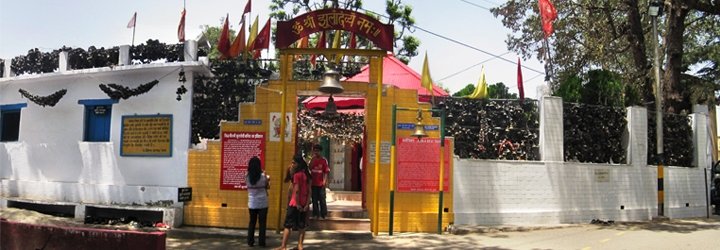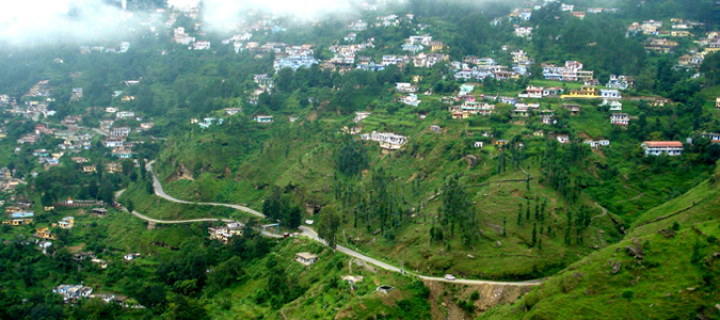The charming hill station of Ranikhet is located in the Almora district of Uttarakhand at an elevation of 1,829mts above sea level. Ranikhet has everything to pacify the nerves of an avid city dweller. The hill station is Ranikhet, literally meaning – Queens Land, is an all season tourist-spot for the admirers of the natural beauty. Ranikhet is a place that reflects the best of the great Himalayas. The charming and majestic views of the pine trees, lush green forests, delicate plant life and attractive wild life, the scented mountain breeze, the fresh and pure, the singing of birds, the panoramic view of the Himalayas sight, all adds to the heavenly and pure feeling of Ranikhet.
Best places to visit in Queen’s Land – Ranikhet
Chaubatia Orchard

The Vantage point located between the gardens provides some of the clearest views of the surrounding hills and landscapes. The Chaubatia Orchards are a home to the Government Fruit research center that is known for its various types of apples. The orchards contain more than 200 varieties of fruits and flowers and are a popular attraction during the season.
Upat Kalika

The home to a marvelous high altitude golf course, Upat and Kalika is located at a distance of 5 kilometers from Ranikhet and is located at an altitude of 1829 meters above sea level. The spot is also famous for the tourists as a viewing spot that offers some of the most breathtaking views of the Himalayas.
Shitlakhet

Located in the Almora ranges, Shitlakhet is an undiscovered gem near Ranikhet. A perfect harmony between tranquility and scenic views, this place is perfect for people looking to spend some time in solitude. The place has some stunning views of the nearby Himalayan ranges with peaks like Nanda Devi and also it remains undiscovered by those of tourists coming to nearby places.
Golf Ground

Ranikhet ‘Golf Course’ or ‘Upat Golf Ground’ is one of the prime attractions of Kumaon tourism in Almora district. It is a nine hole golf course and highest in the Asia located at 6132 ft. Golf course comes under Kumaon Regiment of Indian Army but outsiders can also join the club. It is very natural therefore changes its color from green to brown to white as per the season. In the rainy season it shows excessive green, in summers it changes to brown and in winters, snow converts it into white.
Temples in Ranikhet
Mankameshwar Temple

At a distance of 500 m from Ranikhet Bus Stand, Mankameshwar Temple is a Hindu shrine situated next to Narsingh Maidan in Ranikhet town of Uttarakhand. The Mankameshwar Temple was built in 1978 by the Kumaon Regimental Centre of the Indian force. This temple is committed to three main deities namely Goddess Kalika, Lord Shiva and the pair of Radha-Krishna. Mankameshwar Temple is surrounded by eternal beauty and hence it is one of the most picturesque spots in Ranikhet.
Jhula Devi Temple

At a distance of 5 km from Ranikhet Bus Stand, the Jhula Devi Temple or Jhoola Devi Temple is an ancient temple built in the 8th century, situated near Chaubatia Gardens in Almora district of Uttarakhand. The present temple was constructed in 1935. The presiding deity of the temple is Goddess Durga and it is said that the temple was built to seek Goddess Durga’s protection from the wild animals. According to legend, the dense jungle near the temple was once full of wild animals and leopards & Tigers used to attack local villagers. The villagers prayed to Goddess Durga for protection, and one day Goddess Durga came in a shepherd’s dream and advised him to excavate her idol.
Dwarahat

At a distance of 34 km from Ranikhet & 77 km from Almora, Dwarahat is an ancient town situated in Almora district of Uttarakhand. It is famous for its ancient temples which were constructed mainly by the Katyuri kings and are maintained by ASI. Dwarahat, which means Way to Heaven, was once the principal seat of the Katyuri kings whose empire was stretched from the Sutlej River in the west to river Gandak in the east, and from the Himalayas to the plains, including the whole of Rohelkhand. Later it came under the rule of the Chand Rajas of Kumaon in the sixteenth century.









